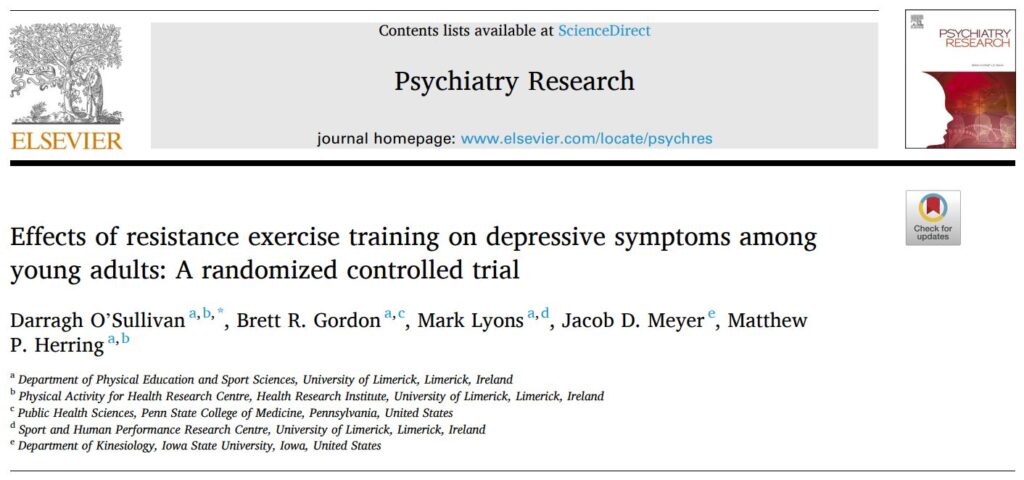An interesting randomized control trial (RCT) was published by O’Sullivan et al in the journal of Psychiatry Research and found that two 25 minute resistance exercise training (RET) sessions a week for 8 weeks resulted in significant decreases in reported depressive symptoms when compared to a wait-list control group. Compared to the effect size of 0.3 – 0.8 of decreasing major depressive disorder from SSRIs, the effect size found from RET by this paper was 1.7 which is considered massive. This study emphasizes the powerful impact adequately dosed resistance training can have on mental health.
More highlights from this paper include:
- RET induced a large 1.01 standard deviation (SD) effect size antidepressant effect at week 8.
- RET induced a large 1.39 SD effect size improvement at week 8 for those with stronger generalized anxiety disorder (GAD)
- RET induced a large 1.71 SD effect size improvement at week 8 for those with stronger major depressive disorder (MDD) symptoms
From 10,000 feet
Study design: Randomized control trial. Two groups. One group worked through two 25 minute progressive resistance exercise training (RET) for 8 weeks, while the other group did not. The RET group experienced clinically-meaningful, large magnitude reductions in depressive symptoms in those with major depression disorder and generalized anxiety disorder. The RET group also resulted in a large-magnitude increase in strength.
The resistance exercise training protocol
Bulleted is the training intervention program in terms of training variables:
- Frequency – twice weekly for 8 weeks.
- Duration – 25 minutes each session.
- Intensity – Participant could complete two sets between 8 – 12 reps before form deterioration, or rep failure. Before jumping into the 8 weeks of RET. Participants completed a 3 week twice-weekly familiarization process to ensure safety, correct lifting technique, and an appropriate beginning resistance.
- Progression – Load progressions were small and gradual. After hitting 2×12 on an exercise load was increased by 5% in the next session. If they couldn’t compete two sets of at least 8 reps load was decreased by 5% in the next session.
- Choice – Picked in accordance with WHO and ACSM guidelines. The 8 exercises were: barbell back squat, barbell bench press, hexagon bar deadlift, seated dumbbell shoulder lateral raise, barbell bent over rows, dumbbell lunges, seated dumbbell curls, and abdominal crunches.
What was the primary outcome and how was it measured?
Depressive symptom severity of the total sample. The 16-item self-report Quick Inventory of Depressive Symptomatology (QIDS) was used to measure depressive symptoms at baseline, week one, four, and eight. There was a large anti-depressant effect among those with major depression syndrome and generalized anxiety disorder who engaged in resistance exercise training. Also, there was a large-magnitude increase in strength in the RET group.
- O’Sullivan D, Gordon BR, Lyons M, Meyer JD, Herring MP. Effects of resistance exercise training on depressive symptoms among young adults: A randomized controlled trial. Psychiatry Res. 2023;326:115322. doi:10.1016/j.psychres.2023.115322

